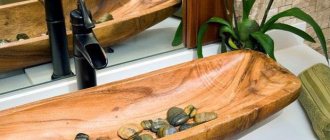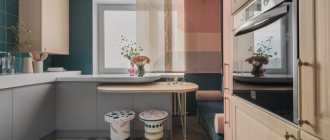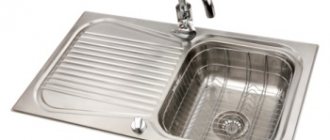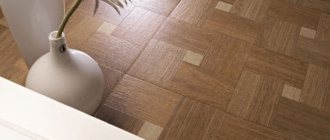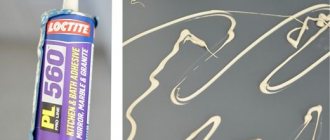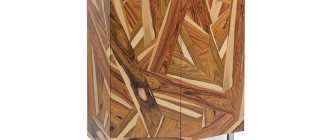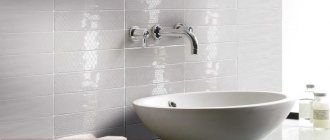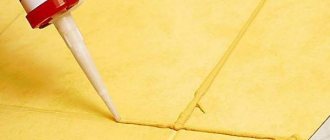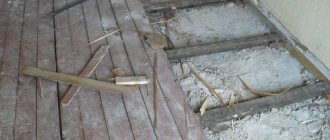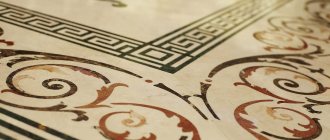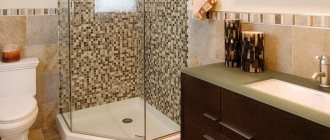Mirror floor tiles are considered a novelty in indoor cladding. Laying this kind of material in the form of a mirror is not difficult, since it is done in the same way as covering walls and floors with simple ceramics. It’s just that the adhesives, grouts, tiles (glass or mirror) and the tools used are different. Therefore, many people are concerned about the question of how to glue mirror tiles and what adhesive composition to choose for it.
Grouting and laying mirror tiles
In our article we will look at how to glue mirror products, the main subtleties of the work, and what needs to be done to ensure that cladding with glass or mirror materials of different textures and colors is done in the best possible way.
Preparation
Before gluing the glass product, it is recommended to carefully prepare the base. In this case, it is necessary to clean the wall from dust, dirt, oil stains and paint. If there are irregularities, holes, chips and other defects, they should also be repaired with cement-sand mortar. If there are large differences in height, the surface is completely plastered.
Preparatory work before gluing glass products
Requirements
Before grouting the mosaic, you need to study the basic requirements for mixtures:
When choosing a filler, you need to consider the following parameters:
Grouting compounds come in two main types: cement and epoxy. They have features that should be considered in more detail.
Laying mirror mosaics without color
The surface of the walls is covered with glass tiles a couple of minutes after applying the adhesive composition to the transparent fragment. Then the tile is gently pressed for a few seconds. Laying is recommended to be done from bottom to top. In this case, be sure to use a building level to check the correctness of the laying of the material.
Important! To ensure the same gap between the individual fragments of the facing material, it is worth additionally using crosses.
Preparing for installation.
Surfaces must be smooth, durable, dry and absolutely clean. It is recommended to sand the surface to obtain a white background. The ambient temperature should be between +5 - +30 degrees. Before starting installation, it is recommended to draw threads on the surface to be coated to help position the sheets correctly. Having spread the sheets on the floor, measure the total size of three adjacent sheets, laid so that the distance between the sheets is equal to the distance between the pieces; transfer this measurement to the surface to be tiled, both horizontally and vertically, so that using a plumb line and level, you can apply the mesh. The wall will be divided into several squares, each of which corresponds to nine sheets of the mosaic.
Grouting joints
To wipe down the glued glass mosaic, you can use the same glue or neutral silicone without color. But it is recommended to wait time for the adhesive composition for glass products to dry well. This may take more than three days. It all depends on the drying conditions of the material, air temperature and humidity in the room.
After drying, the grout can be easily removed from the glass surface with a spatula. If more persistent stains remain, they are removed with a rag and detergent.
Grouting joints without color after laying mirror tiles
Features of laying mirror mosaics.
Features of laying mosaics with mirror surfaces.
Quite a lot of modern mosaics come with the inclusion of mirror chips, which can be either pure pieces of a classic mirror or stylized to resemble various textures such as “crumpled foil”, “glitter”, “crystals”, etc.
To create a beautiful mirror effect of the matrix and different shades of mosaics, manufacturers use a fairly wide range of technologies and chemical additives in the compositions of mirror amalgam. In this regard, the question arises of preserving the original appearance of the mosaic during the process of pasting and its subsequent operation. Since manufacturers keep the exact composition of mirror inserts in the strictest confidence, and at the same time, manufacturers of adhesives and grouts are also in no hurry to reveal their secrets, it is naturally quite difficult to predict how the appearance of such a mosaic may change during the work process. In this regard, I would like to give some advice regarding the use of mosaics with mirror surfaces in everyday life.
- Avoid using mirror mosaics in pool bowls and interiors of wet rooms (baths, saunas, swimming pools, fountains). In general, those rooms where a stream of water can flow onto the surface of the mosaic.
- Be careful about following the technology for mixing the adhesive and grouting with water. Excessive water content in the solution leads to moisture penetration into the amalgam composition and the beginning of a chemical reaction with it, which can worsen the appearance of the mosaic (mainly blackening of the chip).
- Before carrying out work, it is advisable to conduct a chemical compatibility test. You can take a small piece of mirror mosaic and apply prepared glue and grout to its back side. If the reaction occurs, then you will only spoil a small piece of the matrix, and not the entire volume of the material.
- Use anhydrous compounds as adhesives. A number of manufacturers offer epoxy-based adhesives and grouts. With almost 100% certainty, these adhesives will not cause an unwanted chemical reaction in the structure of the mosaic amalgam, and in addition, they will reliably isolate it and attach it to the surface of almost any material. Based on our experience, I can recommend using colorless grout MAPEI Kerapoxy Desing number 700 as an adhesive. Of course, there are also disadvantages of these adhesives - their price, strict adherence to technologies and proportions when performing work, and certain experience in working with such compositions, but the properties of these grouts are so high that they more than cover these disadvantages.
Why choose mosaic
Mosaic finishing is probably the most effective finishing option. A large number of small fragments, with the help of which various patterns are created, attract both near and far and thus decorate the surface of any home. At the same time, stone mosaics can also be used for exterior cladding of a house, resulting in a large number of options for colors, shapes and textures.
Stone mosaics are small pieces of processed stone that have different shapes: square, rectangle, polyhedron, oval, circle. The simplest option is oval stones, popularly called pebbles. A professional version of stone mosaics are square tesserae (chips) ranging in size from 1 to 5 cm, up to 20 mm thick, or in the form of bricks, ranging in size from 1x3 cm to 2x6.
You can use any type of stone for stone mosaics:
- Marble
- Granite
- Basalt
- Quartzite
- Travertine
- Limestone
- Sandstone
- Dolomite, etc.
At the same time, mosaics made from hard rocks are used for exterior decoration, and mosaics from soft rocks are used for interior and decorative decoration.
You can choose the surface to suit your taste; there are absolutely smooth, rough, rough and pre-polished options. The process by which a stone is made smooth and shiny is called polishing. For a rough rough surface, technology is used, either tumbling or sandblasting (both options are performed with a special apparatus). It’s more pleasant to lay polished stone mosaics with your own hands.
Peculiarities
A special feature of the mosaic is the large number of seams that need to be coated with a special compound. In this regard, the consumption of grout will be greater than for the same area with tiles.
It is important to remember that a contrasting color grout will emphasize the geometricity of a smoothly laid mosaic, as well as distortions. If slight unevenness in the installation is visible before grouting, then it is better to refrain from contrasting seams.
In general, all grouts can be divided into two large groups:
- Traditional sand-cement mixture. It has been used as a grout for a very long time and successfully. The availability and low price of the components, as well as satisfactory strength and durability indicators, make it a universal grouting material for joints measuring 3-5 mm. To make work more comfortable, plasticizers and stabilizers are added to this mixture, and to obtain more moisture-resistant seams, they are kneaded with a latex base.
The advantages of cement grouts are:
- Low cost.
- Ease of working with materials.
- Easily remove excess grout from mosaics or tiles.
However, there are a number of negative points:
- The grout is not moisture resistant enough for rooms with high humidity.
- The presence of porosity in the seams, which leads to the accumulation of dust and dirt in them.
- Epoxy grout. Having appeared not so long ago, it has firmly taken its place in the market, thanks to its durability and aesthetics. It is also called “two-component” due to the presence of a catalyst, packaged in a separate package. Before use, it is necessary to mix the grout components with a catalyst to accelerate the curing reaction and quickly fill the joints between the mosaics.
This option should be considered especially carefully when laying mosaics for several reasons:
- Significantly longer service life compared to cement grouts.
- Excellent moisture resistant characteristics. This coating is not afraid of fungus and dirt.
- More attractive appearance. The mixture can be left transparent, or it can be tinted in any color, add glitter or a light-accumulating additive, which will, as it were, illuminate the mosaic from the inside.
- The grout is also resistant to sunlight and has excellent strength and wear-resistant properties.
However, using such a mixture without the skills of a master can ruin the entire appearance of the surface.
Types of grout
There are several varieties:
- cement mixtures;
- substances based on different types of resins;
- elastic materials: silicone-containing, latex.
First of all, the composition of the grout is different. The set of components determines the properties of the material. Inelastic coatings are suitable for joint joints characterized by a small width. If such materials are used in the process of finishing a coating with wide seams, they will quickly deform. This is due to the fact that the tiles are subject to significant loads. The finishing grout in this case should contain polymer compounds (silicone, latex).
There are also materials that differ in the degree of hygroscopicity. In most cases, cement compositions are not intended for processing the seams of tile coverings in rooms where the humidity level is high. Cement absorbs water, which will shorten the service life of the coating.
For use in harsh conditions, for example in industrial premises, more reliable materials are selected. The same applies to coatings for thermal panels with clinker tiles, since they will be exposed to high and low temperatures. This means that the types of grout should be considered not only taking into account the type of decorative coating; the dimensions of the seam joints and operating conditions are also taken into account.
Cement
The dry material is called fugue. It consists of white/gray cement, additives that increase elasticity and moisture resistance. To ensure that the substance is in harmony with the shade of the tile, pigmented compounds are used. Cement grout is divided into 2 types:
- with added sand;
- without fine fillers.
Portland cement is used to increase strength. The advantages of such mixtures include affordable cost. In addition, it is noted that cement types are characterized by simple technology of use. The scope of application of sand-free compositions is wide. They can be used for finishing coatings of various types, including ceramic tiles, enameled products, Camelot porcelain tiles, etc. Cement mixtures of this type are characterized by a more uniform structure.
Grouts containing sand are not suitable for enameled tiles and marble. The presence of fine filler in the composition can cause deformation of the surface of the decorative coating. However, such mixtures have a significant advantage - they can be used to fill wide joints (from 0.5 cm or more).
For comparison, compositions that do not contain sand are used only for finishing seam joints up to 0.5 cm.
Resin based
Such substances dry out instantly, which complicates the task of applying them, since you need to do the job quickly. Moreover, it is important to immediately remove excess material, because substances containing resins are difficult to clean after complete hardening. If you are deciding which one is better to choose, consider the following options:
- based on epoxy resin;
- furan grout.
The first type is a two-component mixture. The composition may include coloring pigments. However, the main components are: epoxy resin, hardener. The result is a mechanically stable seam joint. It withstands exposure to chemicals.
However, epoxy mixtures have significant disadvantages. Thus, they note the high cost and complexity of working with the material, which is why it is more often used on large objects. However, this substance is more suitable than others for finishing tile joints in a bathhouse, swimming pool, or bathroom. This is due to the fact that epoxy grout resists moisture and the formation of fungus.
Furan material is characterized by its black color. It is based on a resin, which is obtained by combining furfuryl alcohol and furanol. The material does not contain water. It withstands moisture and chemical compounds. However, dark grout is not suitable for any apartment or house design. The main disadvantage of the material is the difficulty of working with it. It hardens quickly, so before starting floor/wall repairs, it is recommended to protect the decorative coating with wax. Excess material is removed immediately with hot steam.
Due to the complexity of the process of applying resin-based grout, its scope of application is relatively narrow. Furan material is in demand at large industrial facilities. Epoxy compounds can be a good solution for finishing swimming pools, saunas, and garages.
Silicone
Such materials represent a group of sealants. The advantages of such compositions:
- frost resistance;
- moisture resistance;
- elasticity;
- large selection of shades.
Grout mixtures of this type are easy to apply due to their plasticity. They do not dry too quickly, which allows you to clean the tiles in a timely manner. However, such sealants are more often used as grouting compounds for joints on surfaces in the bathroom. Their main disadvantage is low heat resistance. In addition, such material has restrictions on its use. It is permissible to fill narrow joints with it: from 0.2 to 0.7 cm. Silicone is suitable for different types of tiles: natural, artificial stone, ceramics.
Latex
This substance is used as an independent material and as an auxiliary component of grout. Latex additive is used instead of water if it is necessary to dilute the cement composition. As a result, the properties of the material are significantly improved. Latex grout without additives has the following characteristics:
- resistance to moisture;
- it can be used in conditions of high temperatures without the risk of loss of properties, which allows the substance to be applied to heated floors and used for finishing surfaces on balconies;
- increased elasticity;
- a wide range of designs, different in shade;
- wear resistance.
Due to its ability to withstand exposure to high and low temperatures, this material lasts a long time. The main disadvantage is the high cost.
Colors
In order to highlight the beauty of the mosaic or tile, you need to consider the color of the grout composition.
A few tips will help you choose the right tone:
- The general rule for processing joints is: the grout should be one or more shades darker than the base color of the mosaic. This choice will ensure a harmonious and pleasant appearance of the walls or floor;
- On kitchen surfaces or on the floor, you should avoid light shades of grout, as they will quickly become dirty (especially when using a cement mixture) and will look sloppy;
- For glass mosaics or photo panels, it is advisable to choose colorless epoxy grout. It will not be conspicuous, and all attention will be focused on the beautiful wall;
- Before applying the mixture to all seams, you need to try the composition on a small area and evaluate the appearance. The result may be different from what you expected.
There are quite a lot of color and shade options for grouting compounds. The epoxy-based composition has a particularly wide range. You can find compositions with monochrome, gold or even black mass on sale. However, it should be remembered that the grout is intended to emphasize the aesthetic appearance of the mosaic, acting as an important but secondary finishing element.
If you are in doubt about your preferred color choice, you should choose universal white or a shade that is slightly darker than the main tone of the mosaic. Sometimes a contrasting grout color (for example, black on a white mosaic) can make it brighter and richer, but such experiments are best left to a competent designer.
Application of stone plaster
Hard rock can be used for exterior decoration and therefore hard rock plaster (most often the composition of such crumbs is marble and granite) can be used for the facade of a building. Such material, using acrylic binder glue, becomes another reinforcing layer, which will improve the resistance of the building walls from natural grinding (in the form of rain, snow, wind and sun).
It is necessary to highlight all the advantages of such plaster:
|
Which one to choose?
The choice of grout depends on several factors:
- Room type. Traditionally, a mosaic pattern on a grid is present in rooms with high humidity - a bathroom, a swimming pool, a sauna. But mosaic also looks good as a cladding for fireplaces, and in some cases its presence is appropriate not only on the walls, but also on the floor. Another option for using mosaics is decorating garden ponds, paths and decorating a personal plot.
When located in a damp, aggressive environment or outdoors, the mosaic itself and the seams will be exposed to fungi, moisture, wind, rain, etc. Therefore, epoxy grout is suitable for such options, which will last a long time without replacement or cosmetic repairs. If this is, for example, a wall in a room that performs a decorative function, then you can work using sand-cement grout.
- Transparency. Modern grout does not have to have color. It may also be colorless. The colorless composition gives special beauty to mirror or marble mosaics without distracting attention to itself. However, only epoxy-based mixtures are transparent.
- Durability. When comparing the two groups of grouts, epoxy undoubtedly wins in terms of durability. If cement requires cosmetic repairs and refreshment after a few years, then the epoxy mixture can only be removed with tiles or mosaics during a new renovation. And choosing an epoxy composition at the renovation stage can save a lot of time and nerves in the future, especially for kitchen wooden surfaces and floors.
- Trademark. The market is replete with both types of grouting compounds. Some of them have added components that improve the physical and mechanical properties of the grout, making it easier to work with, reducing material consumption during operation, or making it easy to remove residue from the surface of the mosaic. Experienced craftsmen and novice specialists willingly share their reviews, thanks to which you can choose the grout to your liking.
Manufacturing technique
The larger the grouting area of the stone mosaic, the larger the spatula
| The process of making a stone mosaic is quite interesting and funny. You can do this job yourself and even involve the children in the “game”... You must do the grouting yourself. For a small product, use a small rubber spatula. Cleaning a stone mosaic after grouting will be easier in this case. The larger the area of stone mosaic grouting, the larger the spatula. Take the widest spatula before grouting a stone mosaic of this size. | Now, let’s look at the technique of making mosaics point by point:
|
Traditional natural stone mosaic installation is virtually no different from glass or tile mosaic installation. Above was a description of the production of decorative mosaics for the interior with a base. At the same time, cleaning a stone mosaic after grouting will be quite labor-intensive work, since epoxy grout is used, which is difficult to wash out and requires a certain skill. You should not use simple cement grout, since after water gets in, the seam will not hold each element of this mosaic firmly enough. Grouting stone mosaics is an important stage of work. For example, if the mosaic is laid on the floor and grouted with cement, then the chipping process will begin very quickly and the tesserae will simply fly off, first one at a time, and then in batches. We don’t need to re-purchase material and make repairs!
We recommend that you do not deviate from the technology; laying natural stone mosaics on the wall and floor should be carried out according to the instructions; in the photo, the master “tapping” the material so that it is immersed in the glue and firmly fixed
Consumption
The approximate consumption of grout depends on the geometric parameters of the mosaic - the length, width and height of each element, as well as on the size of the seam between the tiles.
The primary calculation can be made using the formula:
Consumption (kg/1 m2) = (l + b) / (l * b) * h * t * e,
- l – tile length, mm;
- b – tile width, mm;
- h – tile thickness, mm;
- t – seam width, mm;
- e – grout density, kg/dm³. Typically this parameter ranges from 1.5 to 1.8.
10-15% should be added to the resulting consumption. This will be the required amount of materials.
When purchasing a grouting compound, you should pay attention to the fact that the entire volume has one production batch on the packaging. Also, the packaging of many manufacturers indicates the approximate consumption of material, this will also help you make a choice.
It should be recalled that for the same area, the consumption of grouting materials for mosaics will be greater than for tiles. This is due to the large number of elements. Epoxy grout is used more economically than cement grout. This is due to the fact that a large amount of sand-cement mixture remains on the surface of the mosaic and must be removed.
The qualifications of the craftsman performing the work also affect the consumption. The more experienced the worker, the more economically he uses material.
What types of mosaics can you choose?
There are not so many stone mosaic techniques:
- Florentine
- Roman
- Russian
The first technique is used for artistic products and images, it is very difficult to implement. To complete it, you need many stones with different colors and shapes.
The second technique is used to create geometrically correct designs and patterns, using homogeneous light polished stones, mostly small in size.
The third technique is the simplest; stone with a textured, unpolished surface is used to create mosaics. This technique is used mainly for finishing interiors, exteriors and landscape design, and not for creating art objects.
Attention! There are a large number of manufacturers on the market that offer a variety of stone types. However, this product does not require certification. Nevertheless, you need to obtain a specification for the material you are purchasing in order to be sure that it is a stone and not its analogue.
Tips for use
If you have no experience in laying and grouting tiles and mosaics, it would be wise to trust a qualified craftsman: he will do the work in such a way that the seams on the wall or floor will delight you with their impeccable appearance for a long time. However, after some time, it may be necessary to sand down damaged or worn-out finishes. A situation may also arise in which it is necessary to replace a cracked element. In this case, the skills of applying grout yourself will come in handy.
Here are a few tips to help you perform small repairs correctly:
- From the time of fixing the mosaic to applying the grout, at least a day should pass. During this time, the glue will have time to dry, and it will be possible to rub the seams without the danger of the mosaic coming off.
- Before applying the grout, the surface must be cleaned of dirt and cement or glue residues. To do this, use water and a medium-hard sponge that will not damage the mosaic.
- Apply the composition with a rubber spatula using diagonal movements from top to bottom. This will prevent scratches on the decorative tiles. In addition, a rubber tool, unlike a metal one, allows you to deepen the grout 1-2 mm from the level of the mosaic, which gives a more refined and aesthetic appearance to the finished coating.
- During work, it is necessary to constantly moisten the grout joints in order to prevent cracks. Usually a spray bottle is used for these purposes.
- No more than 20 minutes after grouting the joint, it is necessary to remove the remaining composition from the surface. In the case of a cement mixture, repeated wiping with a damp sponge is sufficient. The epoxy composition is easier to remove if the mosaic is pre-treated with a special composition that forms a polymer film.
Additional instructions, which depend on the type of grout, can be read on its packaging. If you do everything according to the manufacturer's recommendations, then a good result is usually guaranteed.
For one of the simplest methods of grouting mosaics, see the following video.
How long does it take to produce
In order to make a mosaic panel according to a specific pattern, say 1x1, a specialist will need less than one day. A student can spend up to 1 month on such work, because this is a very painstaking work that requires time, attention, and patience to arrange the stones in a certain pattern. The drawing is first assembled into certain parts; craftsmen call the assembly canvas a matrix, and only then the assembled part can be glued. Very rarely, assembly is done simultaneously with gluing. The process is not that simple. Both the initial assembly and the process of laying and grouting are complex. Therefore, try to plan the order of the mosaic panel in advance, and if you are planning to make it yourself, then stock up on time and patience, the work ahead will be long.
For newbies! Novice mosaicists imagine the process to be quite simple and think that the mosaic can be selected and laid immediately on the spot, without preliminary laying out, but this process of laying a stone mosaic with your own hands is indeed possible without preliminary work, but only for very professional artists. You need to start creating a stone mosaic with preliminary layout and templates!
Other finishing options
If there is no time for finishing, then you can use a subtype of stone mosaic - mosaic stone plaster. It consists of stone chips of different types, which are bonded using acrylic.
The grain of stone chips is divided into groups of granules of different diameters:
- 0.5 mm (fine grain);
- 0.5 – 1 mm (fine-grained);
- 1 – 2.5 mm (medium grain);
- 2.5 – 3.5 mm (coarse-grained).
These granules, with the help of special processing, have spherical shapes, which give the surface smoothness and eliminate the likelihood of injury from sharp corners of the stone.
Stone plaster can be of different colors, which allows you to create different effects on the surface that is finished with this material.
What grout color should I choose for my mosaic?
1. In color with a monochromatic mosaic: this combination will help create the effect of a single monolithic coating. When going to grout, take with you one element (plate) of the mosaic - it will be easier to choose the right tone.
2. In the color of one of the shades of the mosaic: a multi-colored coating requires a more careful selection of grout to create the desired effect. Seams to match the darkest element will highlight the cladding without disturbing the overall harmony of the color scheme.
INMYROOM tip: When you go shopping for grout, take a sample of the tiles with you. Among the 37 shades of CERESIT CE 40 grout you will definitely find the one you need. But always check a sample of the finished grout - it may differ from the color on the package.
3. Contrasting with the color of the elements: the color wheel will help you here. Shades located opposite each other will be contrasting: for example, for yellow it is purple, for blue it is orange. Of course, such decisions require courage. The “safest” contrasting combination is red, black or dark gray grout on a white mosaic and vice versa.
4. White grout is the most versatile and classic option for decorating a mosaic surface. It always looks beautiful and neat, fits any design and does not require complex selection.
5. All shades of gray: sometimes the use of white grout “simplifies” the interior - then gray shades come to the rescue. They help create a more noble and interesting surface where it is needed: for example, when creating a mirror wall from a mosaic.
Currently, in construction markets and in specialized stores you can find a wide variety of cement-based and epoxy grouts. Choose grout for tile joints based on individual factors. In particular, you need to take into account the operating conditions of the new mosaic.
Ask yourself questions: what kind of physical stress will be placed on the coating? Will it be constantly exposed to chemical as well as thermal stress? You should also definitely take into account the parameters of the seam itself between the pixels - how deep and wide the seam is. In addition, the grouts are matched to the mosaic itself or a little darker. Lately I have been recommending using EPOXY GROUT.
Applying grout
Currently, the range of grouts is very large. There are several options available in stores: these are, in particular, elastic and inelastic grouts, special compositions for rooms with increased mechanical loads, mosaic grouts used in swimming pools, as well as epoxy grouts.
Work can begin after 24 hours from the date of laying the tiles. This time is enough for the glue on which the facing material was attached to completely harden. This requirement should not be neglected, otherwise moisture will destroy the mixture with which the seams are filled. The craftsmen have come up with the best method for grouting the seams on a mosaic:
- There should be no tile adhesive residue on the wall, so the surface must be treated with an acid cleaner.
- Wipe the mosaic with a sponge or terry towel.
- Mix the solution according to the instructions on the package.
- Rub the seams with the prepared mixture, moving diagonally from top to bottom. The main thing is to fill all the seams at once.
- Remove excess solution with a rubber spatula.
- After some time (usually the drying time of the mixture is 30 minutes), wash the tiles. To complete this step, you need to wipe the mosaic with a cellulose sponge to remove excess solution.
- Wait a few days. During this time, the coating must be protected from drafts, moisture, UV rays and temperature changes.
- Wipe the surface with a foam float.
To prevent cracks from forming, during the work you need to moisten the seams with water using a spray bottle.
How to care for seams: tips
The surface must be periodically cleaned of dust and other contaminants. It is necessary to remember: clean seams are the key to ensuring that harmful bacteria will not multiply on the coating. It is necessary to clean it several times a month. For these purposes, use soap solution, vinegar, citric acid or household disinfectants.
You can bleach the surface with peroxide and soda, and disinfect it with bleach. The seams can be washed with a toothbrush, and dirt can be removed and germs destroyed with a steam cleaner. If the light seams have darkened, it means that fungus has formed on them. In this case, you need to clean the old layer and treat the coating with an antiseptic, and then apply a new solution.
Interesting articles:
- How to lay tiles on tiles working technology
- How to remove old tiles in the bathroom with your own hands - technology
- Epoxy grout for tiles instructions for two-component materials reviews
- Grouting the seams of brickwork, how to seal the seams with your own hands. Selecting tools and spatulas
Color selection
If you choose a grout with a suitable shade, you will be able to eliminate the roughness. However, we should not forget about the properties of mosaic: facing material with glass or mirror coating requires careful handling. In this case, the ideal choice is clear epoxy grout. In addition, after drying the mixture may become a little lighter or, conversely, darker. If the reader is interested in what color to grout the mosaic, to solve this issue you need to focus on the following recommendations:
Before grouting the mosaic, you need to choose its color, taking into account the mentioned recommendations. This nuance needs to be thought out in advance, since an unsuccessful shade will spoil the appearance of the room.
What grout color should I choose for my mosaic?
If you choose a grout with a suitable shade, you will be able to eliminate the roughness. However, we should not forget about the properties of mosaic: facing material with glass or mirror coating requires careful handling. In this case, the ideal choice is clear epoxy grout. In addition, after drying the mixture may become a little lighter or, conversely, darker. If the reader is interested in what color to grout the mosaic, to solve this issue you need to focus on the following recommendations:
- The light coating completely merges with the hardened mixture, making the lined surface appear monolithic. This method is an ideal option for hiding defective areas.
- Grout that has a dark shade is useful when you need to zone a room (for example, in combined bathrooms).
- If it is necessary to grout the seams of floor mosaic tiles, it is customary to use a brown mixture for this purpose.
- The use of bright colors is appropriate only in combination with the design of the room.
Before grouting the mosaic, you need to choose its color, taking into account the mentioned recommendations. This nuance needs to be thought out in advance, since an unsuccessful shade will spoil the appearance of the room.
Currently, you can find a variety of types of grout in specialized construction stores. Most manufacturers take into account the trends of modern interior fashion and produce high-quality grout in a variety of colors, and not just traditional white grout. Using such a grout material, you can not only ensure high-quality insulation of tile joints, but also create a complete bathroom interior.
READ MORE: Caiman walk-behind tractor 36 photos features of Vario 340 and 403 models with Subaru engine How to choose attachments Owner reviews
Very often, grout becomes an inseparable part of the interior solution. With its help, you can, for example, smooth out the color of a tiled mosaic and create the feeling of an even, smooth wall, without a single transition. And in some cases, you can create a contrasting color scheme. For example, you decided to choose the color of the mosaic and chose red, and use black grout. Agree, this design option looks very unusual, original and bright.
So, in order to make the design of the bathroom walls stylish and harmonious, it is necessary not only to carefully select the color of the mosaic, but also to find the optimal shade of grout. How to avoid making a mistake?
Take a piece of your mosaic with you to the market or hardware store. Attach a sample from the catalog to your mosaic and find the most suitable option. But this is not enough. After all, when grouting the seams, everything can change. Without grouting, the mosaic is bright because the seams are still empty, but once you grout it, you don’t know how it will look. Take the time and make a sample of several grouts. It's a pity, but they don't do this in stores.
In the same case, if you used different colors of mosaics to decorate the bathroom, select the grouting material to match the mosaic that plays the “first fiddle” in the interior design. By the way, you can make your task easier by choosing the color of the mosaic and the shade of the grout immediately, in one visit to the hardware store. It will be much more convenient.
1. Operating conditions: there are several types of grout (silicone, cement, epoxy), the choice of which depends on the conditions in which the mosaic is located. Whether temperature changes or increased humidity in the room are expected - all this is important.
2. Seam size: before purchasing material, check the seam parameters between the elements - how wide and deep they are (they may vary depending on the brand). The grout manufacturer always indicates on the packaging the maximum permissible joint width - stick to it so that the mosaic lasts a long time and looks neat.
3. Quality of the base: if you plan to lay the mosaic on plasterboard or chipboard, make sure that the grout is sufficiently elastic. Special additives will help avoid cracks at tile joints.
4. Material composition: pay attention to whether the grout has a water-repellent and antifungal effect or whether you will have to additionally treat the surface. Some grouts contain compounds that facilitate the application of the material and subsequent maintenance of the tile cladding. If you are planning to mosaic your kitchen backsplash, make sure that the grout you choose is easy to clean and resistant to abrasion.
REMOVAL OF GROUT FROM THE SURFACE OF TILES AND MOSAICS
It should be noted that the question of how to clean grout from tiles concerns almost everyone who has recently completed renovations in the bathroom or kitchen. Many people are also interested in how to clean the grout itself and how it can be protected from contamination.
Many manufacturers of finishing materials recommend the use of special compounds that provide a water-repellent effect. For example, the Atlas Delfin composition is quite popular. True, you need to keep in mind that the use of such compositions is justified only if you used the most ordinary grout to fill the mosaic joints.
READ MORE: Curtains for the kitchen 147 photos of the subtleties of choosing curtains for window decoration How to choose curtains Curtain design
But if epoxy grout was used, no additional processing is required. Epoxy grout is good because it is practically not susceptible to contamination. And if dirt gets on it, it won’t be difficult to wash it off.
Particular attention should be paid to protecting the finishing material – mosaic. When grouting joints, unaesthetic marks may remain on the beautiful surface of the mosaic. And dirt is most noticeable if you chose a light mosaic, but preferred bright grout.
Keep in mind that you can avoid the problem of removing grout from mosaic tiles by taking some preventive measures. So, in particular, there are special preparations that are applied to the mosaic a couple of hours before filling the joints with grout. The drug forms a protective film on the delicate surface of ceramics. And later you can easily remove it from the surface with one movement of your hand.
For example, in order to protect marble or polished porcelain tiles from contamination with a grout mixture , you can use special compounds from Sopro. The same compositions are recommended for working with some types of mosaics.
Application of resin-based grout
Be sure to remember that choosing a grout color is one of the most important stages in renovating bathroom walls. If you make a mistake with the color, the interior will “fade” and look tasteless. Even the most stylish and expensive mosaic loses its appeal if you choose an inharmonious shade of grout material.
And, on the contrary, a well-chosen shade will help you solve several problems at once. Firstly, a suitable grout color is an excellent way to smooth out some (insignificant, of course) imperfections and defects that were made when laying the mosaic.
Secondly, such grout will help you emphasize the beauty of the mosaic itself. It also happens: the homeowner thinks that he could not choose a mosaic color that is bright enough and original enough. In this case, without grouting, the mosaic on the wall looks rather inconspicuous, but as soon as the seams are processed, it seems that the walls are immediately transformed.
Think in advance which option you like best and make a choice.
When choosing the color of the grout material, remember one very important, and at the same time, elementary rule. If the grout you choose is lighter than the mosaic itself, it will create the feeling of merging the individual tiles on the wall. But in the case when you choose a grout material several shades darker, each mosaic will have bright outlines, and you can create an interesting geometric composition..
If you have chosen photo collages or mosaic panels, which are fashionable today, as an option for decorating your bathroom, then it is best to purchase transparent grout for the joints. Selecting perfectly matching shades can sometimes be very difficult.
Be sure to check the grout before you start using it. Apply to a separate tile and wait until the mixture dries. It is quite possible that the result will not suit you. And if you are lost in the variety of shades of grout for tiles and mosaics, choose white, it is considered universal.
It is necessary to prepare the following devices:
- a small container for diluting the solution (for example, a plastic bucket);
- hand sprayer;
- cellulose sponge and foam grater;
- rubber spatula (recommended width - 150 mm);
- electric drill with mixer attachment.
The last tool is not needed if you need to dilute a small amount of the mixture. A trowel will perfectly replace it.
